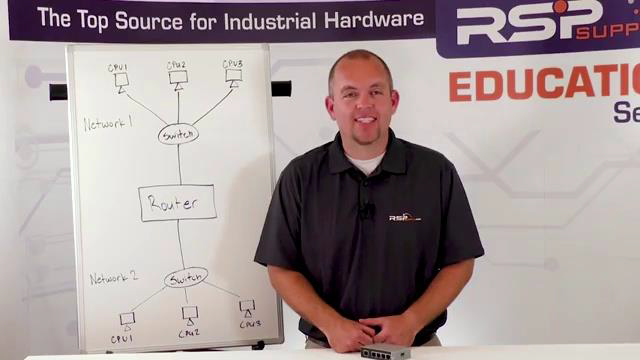Basics_of_Switches_Routers_and_Hubs.pdf
Better understand the differences between these devices and when to use them
Hubs
- The least intelligent of all three devices
- Takes any command and sends it to all devices it is connected to
- Operates more slowly because of the inefficient operation
- All connected devices will see the message that is being sent, regardless of the intended destination
Switches
- Transmits and receives data much like the switch, but is "smarter"
- It can remember what ports that each device is connected to, and can send messages to only the device intended to see the message
- Uses a Switch Table and Mac Address of devices to identify proper routing locations
- Faster than a hub because of the more efficient operation
Routers
- Can do everything a switch can, but with added functionality
- Allows one network to communicate with another network
- Allows a network to communicate with the Internet
Transcripts:
[0m:4s] Hi I'm Josh Bloom, welcome to another video in the RSP Supply education series. In today's video we want to discuss the differences between hubs, switches, and routers. We also want to discuss in what scenarios we might use each device and why. Ethernet hub switches and routers are all devices that let you connect computers to other computers, or other network devices, or even other networks. Each of these devices has two or more connection points called ports, which we see here, that we connect the network cables into. Once the cables have been plugged in the device, they will start to talk with one another and other devices on the network. The way in which they talk with these devices is very different and can dictate which device we want to use in a particular application.


[0m:47s] It is very common to see these devices and their functionalities get confused, so we want to clarify the intended use for each device and why we might use it.
[0m:56s] First let's discuss the Ethernet hub, which looks very similar to this device here. The Ethernet hub is the least intelligent of the three devices that we're going to be discussing today. It simply takes any message that is received and transmits that message to every other
[1m:10s] device connected to that hub. For example,
[1m:14s] if CPU one on our network wants to send a message to CPU 5,
[1m:19s] it will send that message through our hub. That hub will then take that message and send it out to every connected device on that hub regardless of the intended target. Also, when CPU five receives that message and wants to respond, it will send its response through the hub and that hub will then, again, send that message to every connected device on that hub. So, a few disadvantages to using a hub in any network, is that the hub does not manage any of the data being sent in any way. This can really bog down our network because the hub is simply sending messages to every device connected to that hub. It also offers very little if any security for your network. It's because of these disadvantages that in most cases, hubs have been replaced by network switches. Let's talk about switches. Much like a hub, a switch, which we have here,
[2m:8s] is a device that is intended to transmit data from one device to another with any given network.
[2m:14s] Unlike a hub, a switch can learn where that message needs to go. It can also learn where that message came from. It uses something called a switch table. The switch table stores which port a particular device is connected to. It also stores the Mac address, like a physical address within a network of every device connected to that switch. By storing this data, a switch can operate much more efficiently than a hub can. It also greatly reduces the traffic within the network. Let me demonstrate an example of how this works. In this scenario, CPU one wants to send a message to CPU five. It sends that message through the switch.
[2m:51s] In this case, the switch knows where that message came from and the intended target. So, the network has the opportunity to operate much more efficiently. Because of these efficiencies, it allows data to be transferred between other network connected devices with less congestion. This makes the switch a great choice for almost all network solutions. The only disadvantage in comparison to the hub is cost, although the cost of switches has become very reasonable in recent years.
[3m:17s] Lastly let's look at routers and what sets them apart from the other devices that we discussed today.

[3m:22s] Much like a network switch, a router can transfer data between devices while learning the location of those devices within the network.
[3m:30s] It also performs other very important tasks. It can act as a junction between two or more networks, as you can see here.
[3m:38s] An example of this might be a home router
[3m:41s] in which the home network is connected to the Internet. Another enterprise example might be when the router connects two or more networks with different business functions. In addition to connecting two or more networks, a router offers important security features that help protect our network. As you can see, all the devices we've discussed today are important in setting up a network in our home or places of business.
[3m:44s] Another enterprise example might be when the router connects two or more networks with different business functions.
[4m:4s] Although each of these devices has a very specific function and one used correctly can help us assist in making a fast and secure network. For a full line of hubs, switches, and routers, or thousands of other products, please visit our website. For more information or other educational videos, please go to RSPSupply.com, the Internet's top source for industrial hardware. Also, please don't forget: like and subscribe.

